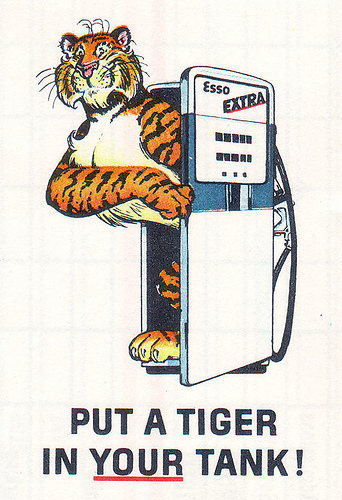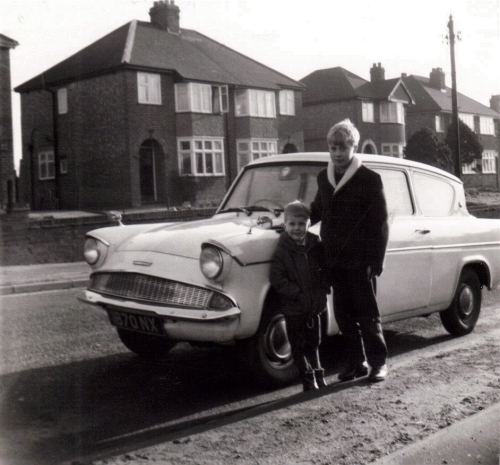Like a lot of families in the 1950s we didn’t have a car and had to rely instead on public transport. Dad leaned to drive in 1962 when he took lessons with Terry Branston’s school of motoring.
In days when footballers didn’t earn loads of money and live in mansions Terry lived opposite to our house and well as being a driving instructor was a professional footballer who played for Northampton Town. He was a tough tackling centre-back who helped Northampton achieve the impressive feat of moving from Division Four to Division One in three successive seasons in the early 1960s.
I think Dad failed the first time and he was distressed about that but once he had passed his test at the second attempt he bought his first car, an old fashioned four door white Austin Cambridge A40 saloon registration number SWD 774. The Cambridge had been introduced in 1954 and was kept in production for two years. It had a straight-4 pushrod B-Series engine with a maximum power output of 42 brake horse power and at 4,250 revs per minute an alleged top speed of 71 miles per hour. Power was transmitted to the back wheels by means of a four speed gear box controlled with a column mounted lever.
It was a big heavy thing, hard to handle, I imagine, and by modern standards hopelessly inefficient, it only managed a disappointing thirty miles to the gallon or so but with a gallon of leaded petrol costing only five shillings (twenty-five new pence) this really didn’t matter too much. I can remember Dad pulling into a garage where an attendant put four gallons in the tank and dad handed over a crisp green one pound note! I wish I could do that! Dad always insisted on buying Shell petrol because he thought it possessed some sort of magic ingredient but at one point we successfully nagged him to buy Esso so that we could get the gold and black striped tail to hang around the filler cap to show other motorists that the car had a tiger in the tank!
On the outside it had a voluptuous body shape, lumpy and bulbous, extravagant bumpers and grill, round bug-eye lights with chrome surrounds, the Austin badge in the middle of the bonnet and the flying A symbol on the nose at the front. It was a curious shade of white, a bit off-white really but not quite cream with ominous flecks of rust beginning to show through on the wing panels and the sills.
I would like to be able to take a drive in it now to fully appreciate how bad it must have been and with narrow cross ply tyres it must have been difficult to handle. Dad obviously had some problems in this department because he had two minor accidents in it. On the first occasion he misjudged his distances when overtaking a parked car and clipped a Midland Red bus coming the other way, he was upset about that especially when he got a bill to pay for the damage to the bus.
The second occasion was a bit more dangerous when a car pulled out on him from a side street somewhere in London and, with no ABS in those days, dad couldn’t stop the car in time and did a lot of damage to the front off side wing. Fortunately this wasn’t his fault and someone else had to pay for the repairs this time.
Having an accident like this in 1964 was potentially quite serious because cars didn’t have seat belts and in a crash passengers could be tossed around as though they were in a food blender Drivers and front seat passengers were not compelled to wear seat belts until 1st February 1983 by which time the Department of Transport estimated that thirty-thousand people a year were being killed or seriously injured in road accidents. It seems bizarre now to think that there had been a long running row over making front seat belts compulsory which had been going on for fifteen years with eleven previously unsuccessful attempts to make it law.
And it wasn’t just seat belts that the A40 lacked because in the interior this was a car with few refinements and even lacking modern day basics such as a radio, air conditioning or satellite navigation. There were no carpets and the seats were made of imitation red leather that were freezing cold in winter and if you weren’t especially careful burnt your arse in the summer if the car had stood out in the sun for too long. For the driver there was a big skeletal steering wheel, column mounted gear stick and a hand brake that was adjacent to the steering column on the left hand side.
The controls consisted of a simple dashboard display with a basic speedometer with warning lights for oil and water, headlamps and indicators. The ignition key was in the middle of the dashboard alongside the manual choke and the knob to control the windscreen wipers. There were clumsy air vent controls for the driver and the front seat passenger, a long open shelf for keeping miscellaneous motoring clutter and a glove box for the AA book and important membership details.
Dad only had the A40 for a couple of years and after that he had a white Ford Anglia, 1870 NX, which I always thought was a bit chic and stylish with that raking back window and flashy chrome grill. Then he had a two tone blue and white Ford Cortina Mark I and he must have liked the Cortina because after that he had first a blue one and then a white one. Sometime in the early 1970s he traded up from a Mark I to a Mark II and had a model in a curious duck egg green.
These were all second hand cars of course but then in 1975 he had his first brand new car when he paid £800 for a metallic gold Vauxhall Viva, which he kept for four years before selling it to me (for £800, I think). After that he had a succession of red Ford Escorts before finally downsizing to Ford Fiestas, and back to his favourite blue again.
My first car was two tone blue Hillman Imp which was a twenty-first birthday present but it was unreliable and would only go for about thirty miles before seriously overheating so I only kept it for a few months and I bought my own real first car, a flame red Hillman Avenger top specification GL, 1500cc, registration WRW 366J, which featured four round headlights internal bonnet release, two-speed wipers, brushed nylon seat trim (previously never used on British cars), reclining front seats, hockey stick rear light cluster and a round dial dashboard with extra instrumentation.











Ah, memories of setting out on journeys in our Ford Prefect EFE 987, with car blanket across our knees in a vain attempt to keep warm!!
So you remember car registrations as well? So glad I am not the only one!
Pingback: Krakow, Eric’s Crazy Guide Communist Tour « Have Bag, Will Travel
Pingback: Poland, Communist Central Planning – The Trabant « Have Bag, Will Travel
Pingback: Poland, Communist Central Planning – Cities « Have Bag, Will Travel
Pingback: A Life in a Year – 22nd July, Nowa Huta Steelworks in Krakow « Age of Innocence
Pingback: Early Days, 1954 Part Two – Rationing, Bananas and a First Car | Have Bag, Will Travel
Pingback: Memory Post – First Cars | Have Bag, Will Travel
What I remember most about this were the blue flairs you wore while posing in front of the Avenger. But it all goes to show how inefficient the early cars were.
That Avenger was also a rust bucket. Good job it was red.
Thirty miles per gallon is pretty good by today’s standards and certainly for back then . . . or am I misreading that?
I expect to get 60 miles per gallon these days in my Volkswagen.
. . . wasn’t it VW that tweaked their mileage claims?
That said, it depends on the car (size, weight, capacity) and the type of driving one does. My Highlander averages close to 30. My Burb was doing good at 19.
My comment is born of the knowledge that fuel efficiency wasn’t a priority back then.
When fuel was cheap mpg didn’t matter.
One day I might go electric.
My Dad also thought that Shell petrol had a mystery ingredient. He believed that it cleaned your engine as you used Shell petrol. The only old price I remember was 6/11 a gallon but I couldn’t put a date to it, perhaps mid-sixties?
I remember Dad asking for 4 gallons and handing over a pound note.
‘My’ first car was a 1954 Chevy, Andrew. It was actually the family’s second car but I used it most of the time. I would have been 16-18 at the time. Many adventures, most related to dates. I didn’t need a car at college or in the Peace Corps, so I bought my first car when I got out of the Peace Corps, a Beetle. –Curt
Thanks for adding your story Curt
My very own first car, bought when I was in my late 30s, was a second hand MGA 1600, registration RJB 158. My husband and our son restored it to its original colour of British racing green.
It was good in fair weather, but a cow in winter (rain came in between the top and the windscreen.) The wipers did their best, but it could be scary in heavy traffic, and too darn hot to drive in our summers in Australia. It had twin carburetors, which seemed to demand frequent tuning.
I do sometimes wish I still had that car.
Thanks for adding your first car memories.